Brief

Executive Summary
- Customers in mainland China are happy with their banks. More than half of retail banking customers like and would recommend their primary bank.
- Mobile is one of the most-used channels and has the greatest impact on customer experience, as measured by the Net Promoter ScoreSM.
- Customers want mobile apps with extensive functionality, built-in rewards programs, and lifestyle services. They also want simple digital experiences and reliable access to human support.
- To be competitive, banks must develop customer-centric capabilities, create seamless customer journeys, and optimize human and digital interactions.
The retail banking market in mainland China
In mainland China, the retail banking industry is shifting toward quality growth over quantity.
The retail banking market grew rapidly from 2010 to 2015, keeping pace with a prospering stock market. Then capital market fluctuations and credit tightening tempered the market and slowed the growth rate.
Retail banking is on the rebound now—but in an entirely new set of market conditions. Today’s banks are combating stronger competition, tighter compliance controls, and headwinds from volatile macroeconomic conditions.
Customers are also more demanding than they were a decade ago, especially when it comes to digital experiences. The Covid-19 pandemic caused a surge in digital banking behaviors that never fully subsided. Now, digital banking is a predominant part of the banking experience.
To learn more about consumers’ digital banking experiences and preferences, Bain & Company surveyed 1,800 retail banking consumers in mainland China from August to September 2022. We used the proprietary Net Promoter Score℠ to measure customers’ experiences with state-owned banks, national joint-stock banks, and foreign financial institutions. Customers reported on multiple facets of experience, such as relationship (rNPS), channel (cNPS), product (pNPS), and episode (eNPS).
As part of the analysis, we classified respondents as brand “promoters” or “detractors.” Net Promoter Score classifications are significant because they correlate to quantifiable business metrics, like lifetime customer value and acquisition costs. In mainland China, on average, promoters purchase 37% more product categories from their primary financial institution than detractors. Promoters are also more loyal customers (see Figure 1).
Promoters deliver more value to their primary financial institutions

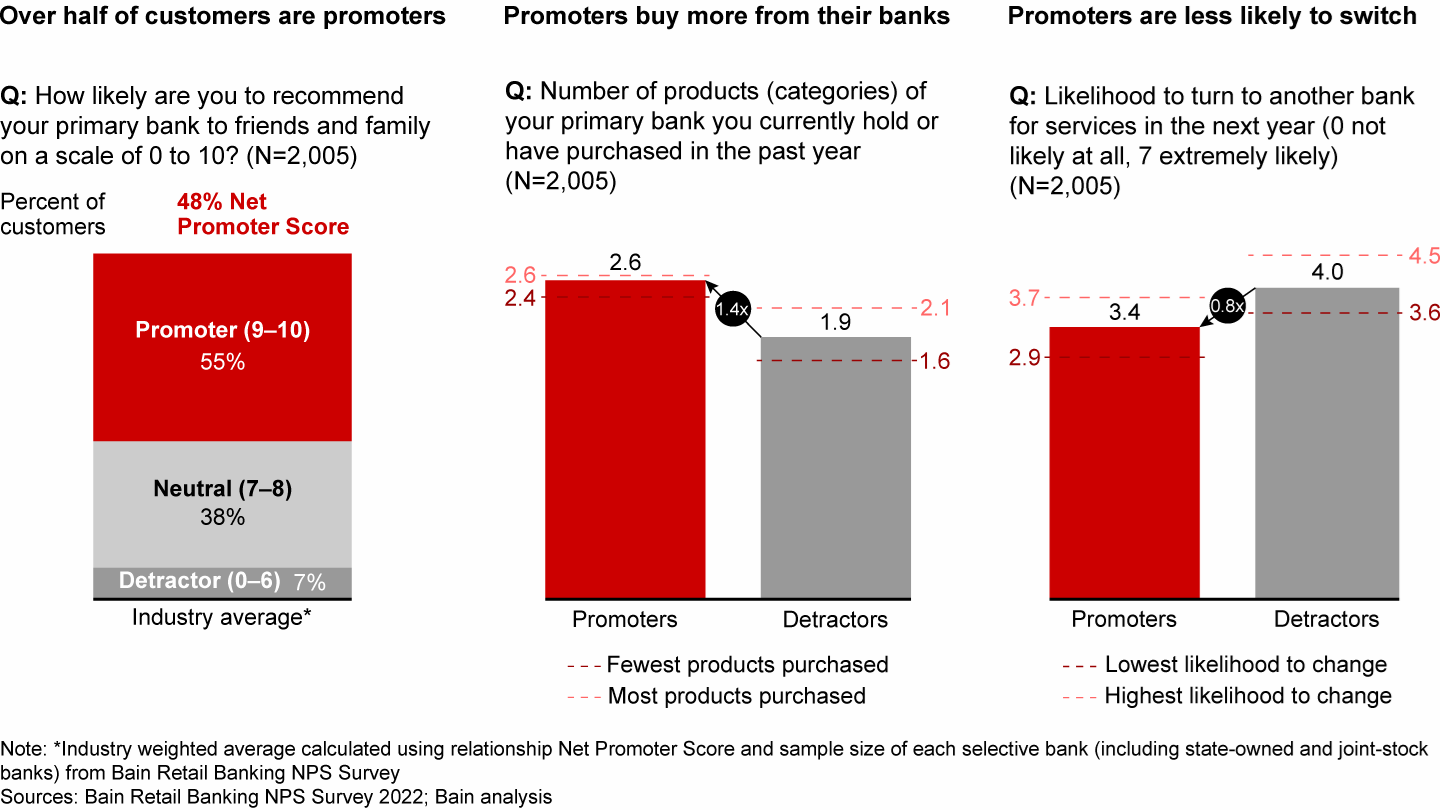
Generally, mainland customers are happy with their primary financial institutions. Net Promoter Score percentages are strong and steadily increasing. In 2022, approximately 55% of retail banking customers in mainland China said they would recommend (or “promote”) their primary bank.
Between 2019 and 2022, the average rNPS of major retail banks in China rose more than 60%. The market average is catching up to the top five banks’, which earned rNPS scores between 47% and 59% in 2022.
If a majority of customers in China are happy with their banking experience, how can retail banks drive deeper relationships with customers?
How to take digital banking experiences to the next level
Customers told us they want retail banks to address four critical areas related to customer experience. They want smooth omnichannel experiences, “super app” functionality, blended wealth management services, and simple digital experiences.
1. Customers want omnichannel experiences
Mobile and online banking are the most frequently used channels among the retail banking consumers we surveyed. Consumers interact with their bank via mobile app about 15 times per quarter, which is five times more often than they visit a physical branch. Mobile banking also has the highest correlation to positive overall customer experience.
However, there is one area where mobile channels were outranked. Despite lower usage, branch experiences are more likely to delight customers, and they have a higher chance of converting customers into promoters or detractors than mobile apps (see Figure 2).
Positive branch experiences can convert customers into promoters

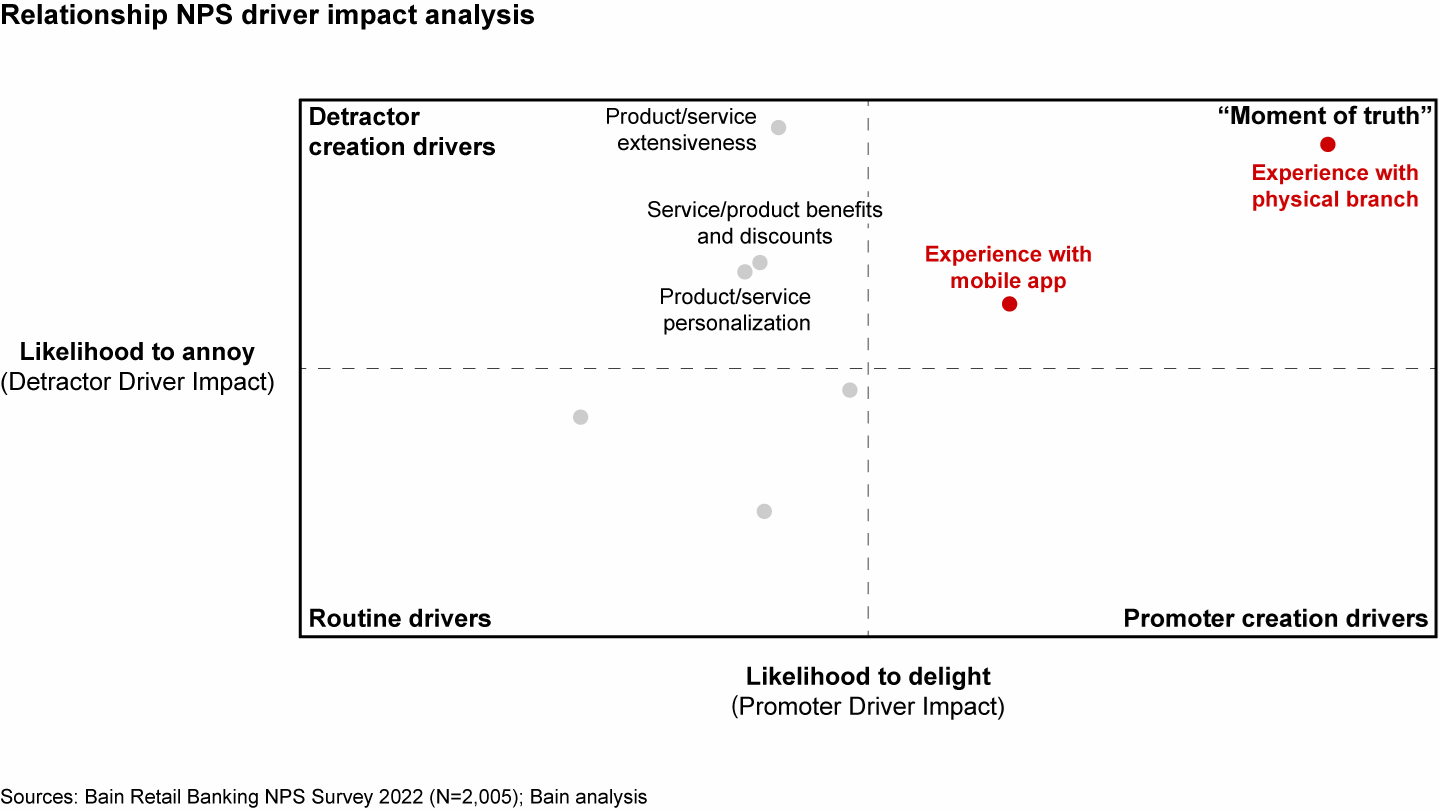
Branch interactions stand out because they often occur during complex or emotionally charged episodes. Customers say they prefer in-person assistance with mortgages, wealth management, and large cash transactions—“moments of truth” that can make or break their sentiment toward the bank.
That doesn’t mean customers want all of their banking interactions to be at the counter, though. Customers want a blend of digital and human services.
In wealth management, for example, human interactions help build trust with the bank at the start of a relationship or when complicated information is being exchanged. Later in the journey, customers are happy to perform simple transactions, performance reviews, and redemptions through digital channels.
Omnichannel capabilities can help banks deliver more consistent and positive customer experiences overall. Banks should make it easy for customers to switch between physical and digital channels. To encourage omnichannel interactions, banks can include or embed digital experiences in their branches.
2. Customers want “super app” functionality
On average, customers are happy with their banks’ mobile apps, but they want more features. They want more functionality, plus access to rewards and lifestyle services. They also want mobile apps to be intuitive (see Figure 3).
Chinese banking customers want “super apps” with extensive features and intuitive functionality

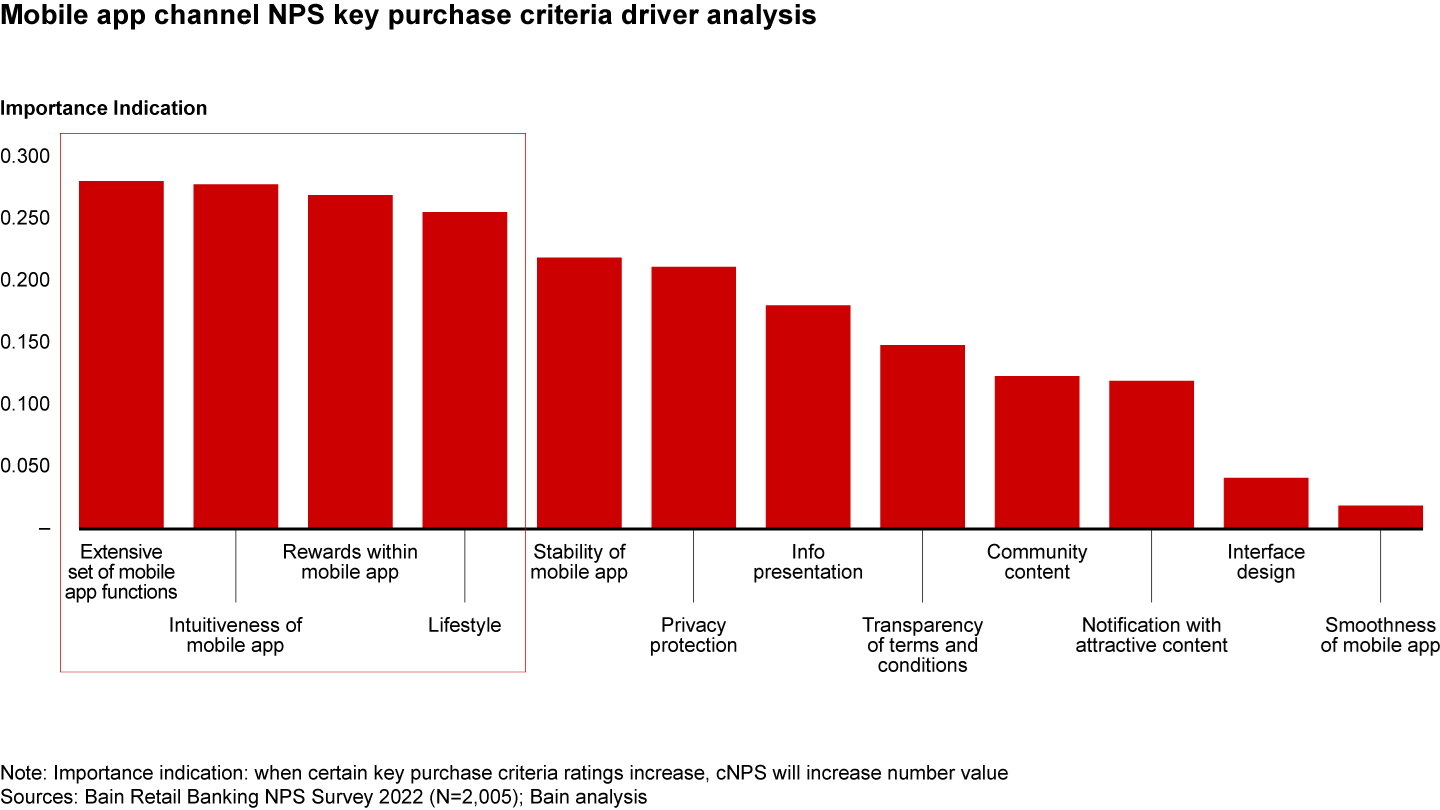
Similar to branches, there are mobile “moments of truth” that can elevate customers’ experiences. Based on our survey data, great in-app experiences related to credit cards and wealth management episodes are most likely to create promoters or detractors (see Figure 4).
Within mobile apps, credit card and wealth management features have the greatest impact on customer experience

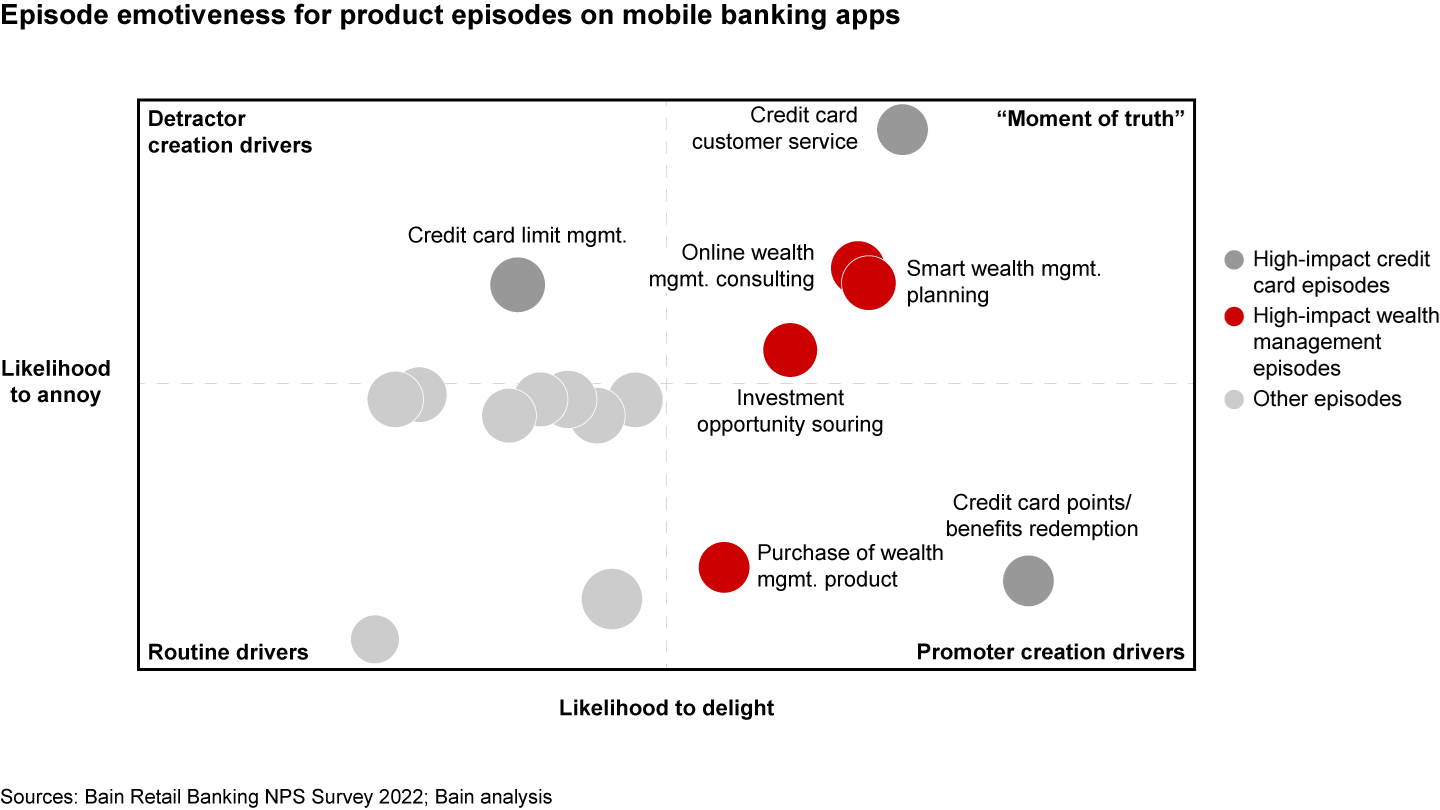
Within credit card products, interactions related to customer service, benefits redemption, and credit limit management are the most influential. For wealth management apps, consulting and smart planning events are the most important.
Many banks added nonfinancial functionality to their apps to drive mobile usage. However, customers prefer modules that tie into their financial lives. Reward modules and bill payment features can drive usage and customer experience, while customers are indifferent to discussion forums and gamification (see Figure 5).
Rewards and bill payments can drive mobile usage and delight customers

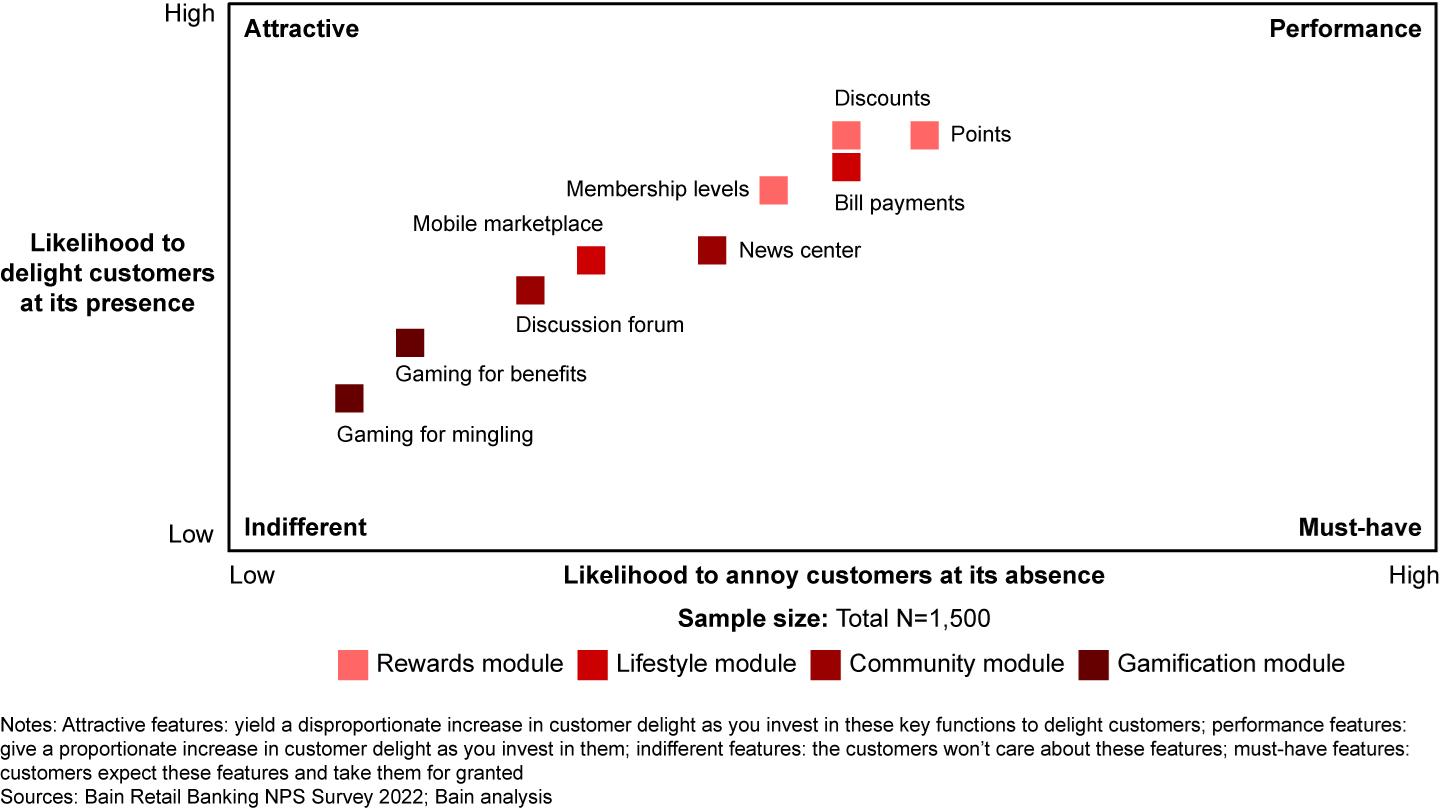
3. Customers want human and digital wealth management services
Digital channels are used for most wealth management interactions, but customers aren’t ready to give up human services altogether. Physical branches and customer hotlines are still essential for parts of the journey and for certain customer segments.
Wealth management is often intermingled with life planning and, thus, has more emotional “moments of truth.” When customers can’t reach human support during a mobile wealth management episode, it creates a negative experience.
A lack of human intervention and guidance is the biggest pain point for mobile wealth management planning users. For wealth management consulting, consumers say automated text consultations are ineffective. Customers also get upset when they have to be transferred to different channels to resolve their issues.
Banks need to use all of their available channels to serve wealth management customers. Overall, customers want easier access to human support, timely assistance, and smooth transitions between human and digital support (see Figure 6).
Mobile users need human support for wealth management queries, consultation, and issue resolution

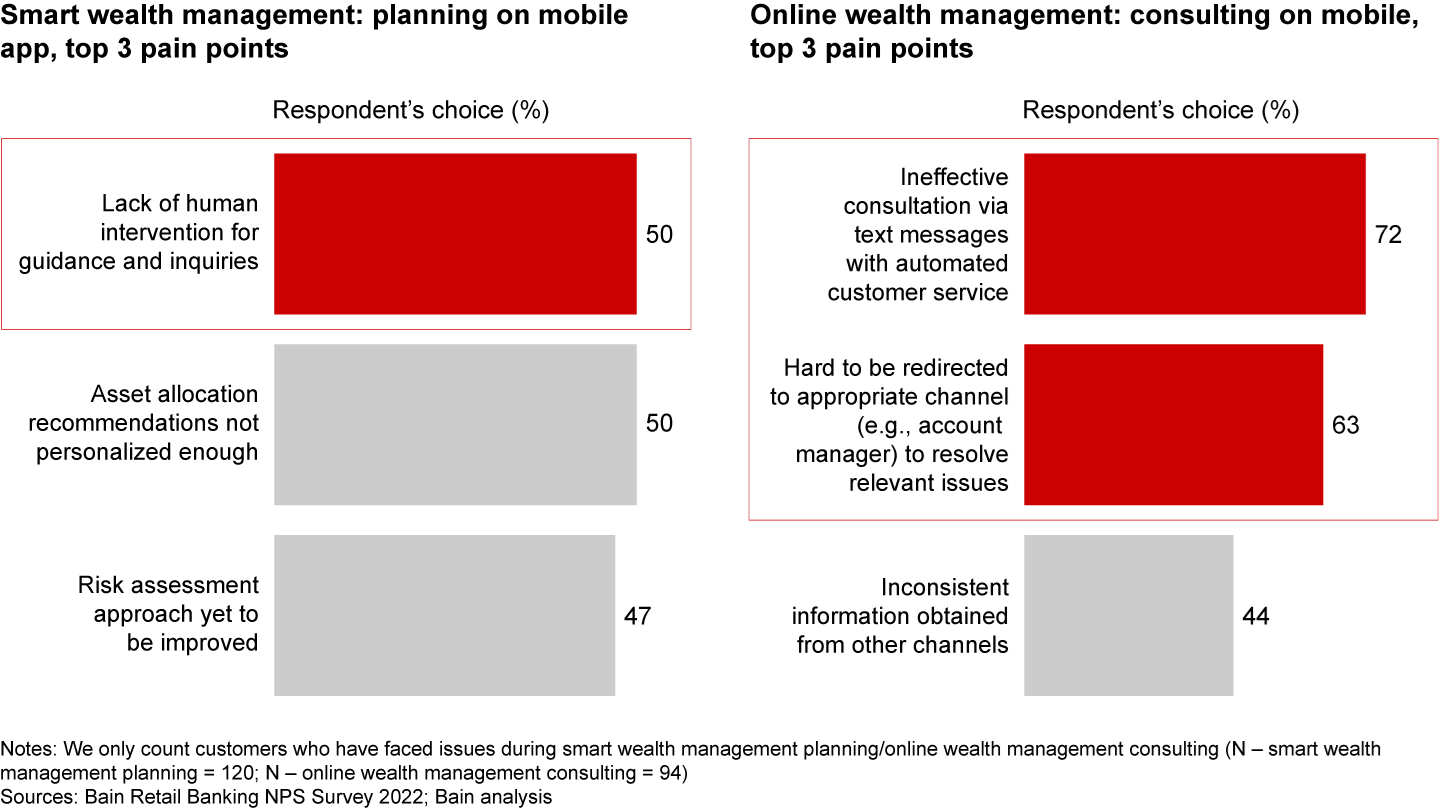
The balance of human touch vs. digital will vary based on customer segment and phase of the customer journey (see Figure 7). For example, banks can offer human-delivered services to their most affluent consumers in any stage of the journey or channel, but use digital self-service, automation, or artificial intelligence (AI)-driven solutions to serve the mass market. For the affluent market, banks can also use digital services to support human interactions, such as video calls or chat.
Wealth management services will blend digital and human touch, based on segment

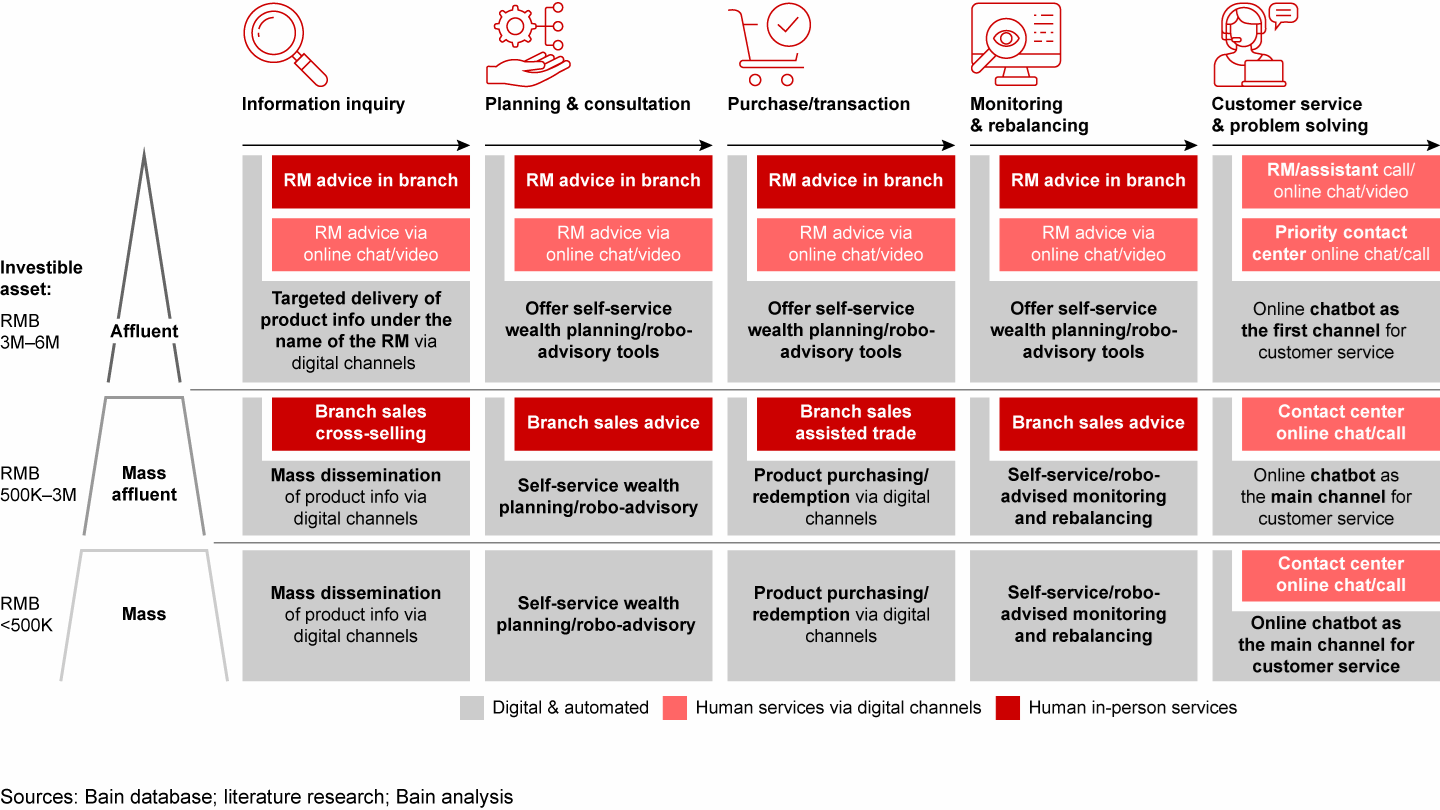
Customer service and problem resolution are frequently digitalized today, and a wide variety of digital approaches are already in place.
4. Customers want simple digital experiences
Fintechs created a compelling value proposition based on customer experience, which inspired an uplift in customer experience across the market.
Because they were built to be digital-first (or digital only), fintech platforms are more intuitive, inclusive, and convenient than those from traditional banks. For example, at WeBank, consumer credit line applications can be completed in “one click.” And Ant Group issues and activates microcredit cards online through a simple, two-step application process. Customers only have to click a button and establish a password. There’s no waiting for confirmation, authentication, or approval.
Fintechs also widened the market for financial services. For example, Tencent’s LiCaiTong uses a digital wealth management platform and robo-advisory services to deliver a range of investment services to the mass market. In most cases, there’s no minimum investment requirement. With some providers, consumers can invest as little as RMB 10.
Digital capabilities can help financial institutions reach more customers and serve them well. To compete, traditional banks must expand their digital capabilities, specifically around AI, big data, cloud computing, and automation.
At the same time, banks need to deliver simple digital experiences. Mobile navigation should be intuitive and “stress-free,” even for complex products and services.
Key actions for banks
Traditional banks have long-standing relationships and deep customer knowledge to their advantage, but they face more organizational, system, and capability challenges as they transform into customer-centric players. There are three stages of development traditional banks can follow to improve customer experience at scale (see Figure 8). The starting point may vary based on how sophisticated and customer-centric a bank is today.
Banks can become more customer-centric in three stages

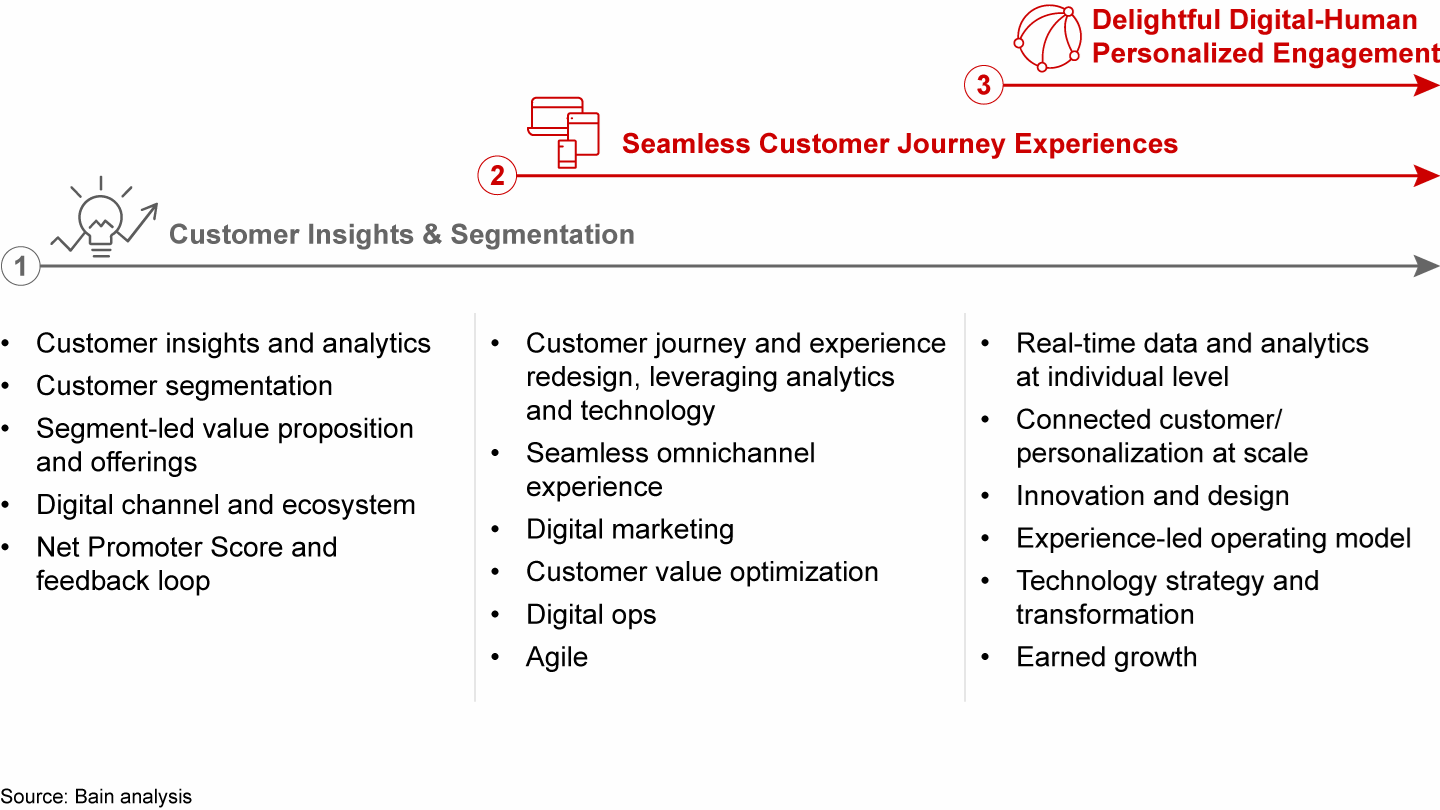
Stage 1: Develop segment-based customer insights and propositions
In this phase, banks need to build core capabilities in customer insights and analytics to understand their position in the market. They should examine their culture, strategy, and performance benchmarks to identify gaps and opportunities. They also need to use all available data to establish their position, ideal customer segments, and segment-led value propositions. From there, the digital channels and ecosystem needed to deliver value will come into focus.
Research and analysis are not “one and done” events. Banks should use measures such as the Net Promoter Score to continuously collect feedback and adapt the customer experience strategy.
Stage 2: Create a seamless customer journey
Next, apply customer insights to create seamless, omnichannel customer journeys. Start with products or performance areas with the highest potential to affect Net Promoter Scores, such as mobile wealth management. Create a customer experience roadmap to identify priority use cases, then determine how and when to scale technologies.
Remember, technology isn’t supposed to digitize the traditional banking process. Rather, it’s intended to enhance the experience and value for customers. Continuous feedback loops and sentiment monitoring can keep development efforts on the right track.
Stage 3: Optimize digital and human engagements
By leveraging advanced data analytics, banks can blend digital and human engagements to create ultrapersonal interactions and delight customers.
Real-time data and analytics can be applied at the individual level, whether customers are at the counter or on a mobile device. To achieve personalization at scale, traditional banks need experience-led operating models and customer-driven cultures. Some banks may also need to upgrade their data and IT infrastructure to support more advanced customer experience capabilities.
As the dimensions of customer experience become more complex, traditional banks will need new ways to measure customer relationships across products, channels, and journeys. Continuous, high-velocity feedback loops will be necessary to benchmark performance, make timely and effective decisions, and delight customers.
Customer-based accounting can also help traditional banks measure earned growth that results from customer experience. Combined, customer-based accounting and dynamic sentiment tracking (such as the Net Promoter Score or NPS Prism℠) can help traditional banks create delightful experiences.
Conclusion
Customers in mainland China are satisfied with their banking experiences—for now. But competition is intense and customer expectations are steadily rising. Banks must continuously elevate their digital game. To retain and delight customers, they need core capabilities in customer centricity.
Customer experience should stay at the forefront of innovation, and every product and service should have a digital path or component. Positive digital experiences can keep customers happy, inspire loyalty, and encourage purchasing.
It’s vital for banks to listen to customers. They are the best source for feedback, opportunities, and sustainable growth. Banks that delight customers—on any channel—will find exciting ways to grow.